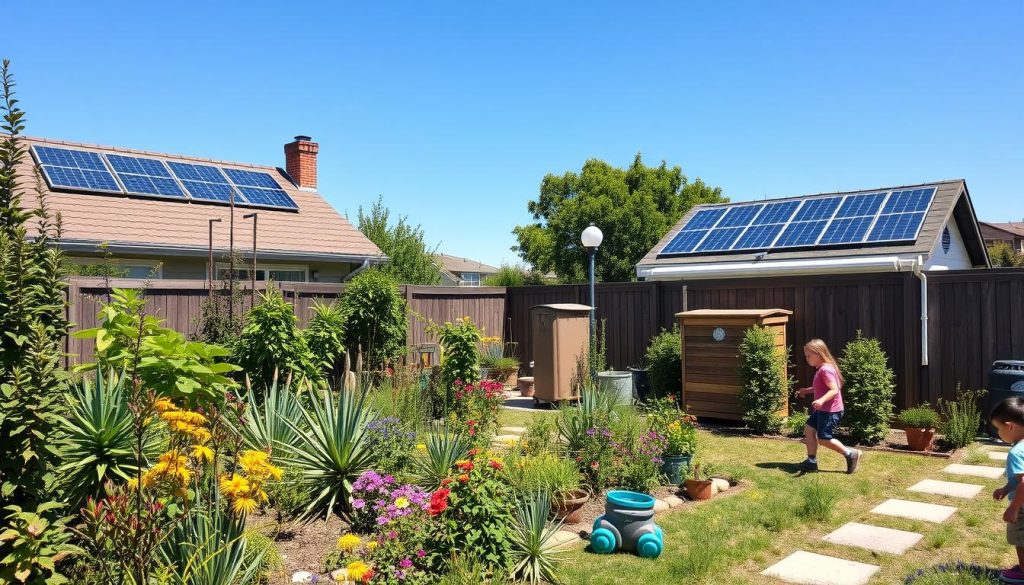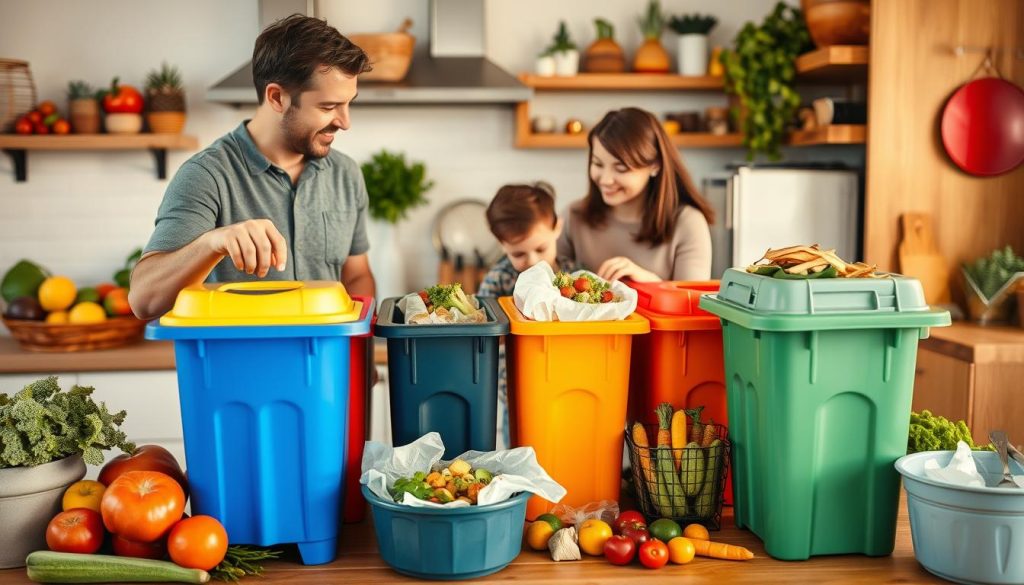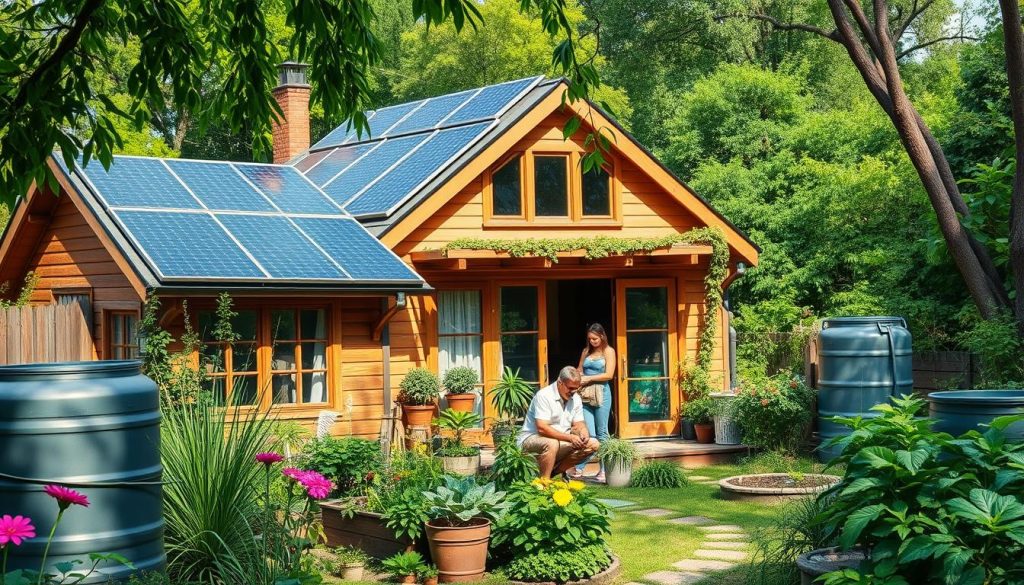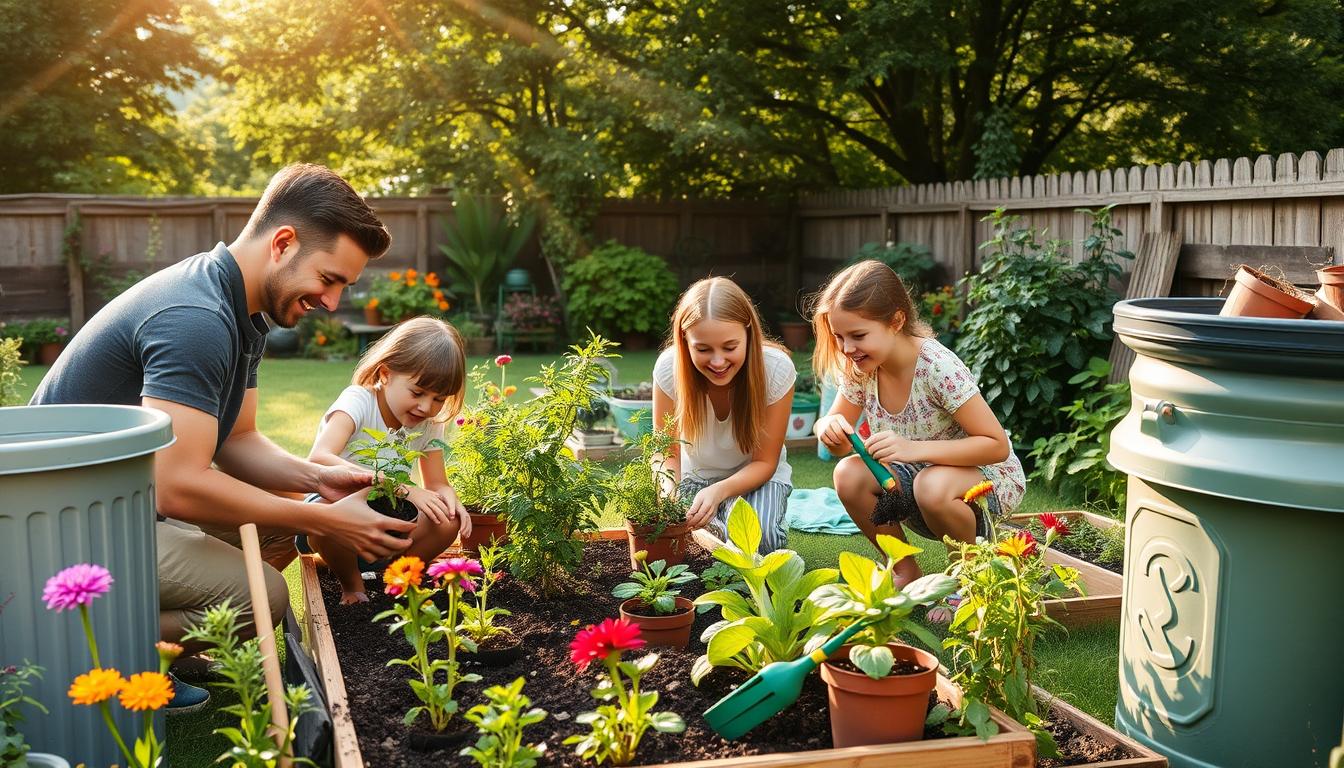Have you ever thought about how small changes can make a big difference for the planet? Living eco-friendly is key today, but many parents feel stuck. It’s not too late to start. Simple steps can help your family live greener, stay within budget, and be kinder to each other.
Being eco-friendly is good for the planet and your wallet. It’s about making smart choices in energy and food. This article will show you how to make these changes easy for your family.
Key Takeaways
- Understanding the true meaning of eco-conscious living
- Importance of reducing your environmental footprint
- Simple modifications in food choices to minimize waste
- Switching to renewable energy sources for your home
- Choosing sustainable clothing options
- Implementing eco-friendly home and lifestyle changes
- Navigating the challenges of parenting in an eco-conscious household
Understanding Eco-Conscious Living
Eco-conscious living means making choices every day to help our planet. It’s about knowing how our actions affect the environment. This includes reducing waste, using less energy, and making smart shopping choices.
This lifestyle fits with sustainable living. It’s about using resources in a way that doesn’t harm the planet.
What Does it Mean to Be Eco-Conscious?
Being environmentally conscious means thinking about how our actions affect the planet. The Brundtland report says sustainable development meets today’s needs without harming tomorrow’s. This means choosing organic cotton, wooden toys, and other green products, especially for kids.

The Importance of Reducing Your Environmental Footprint
It’s key to reduce our carbon footprint for the future. Disposable diapers, for example, take ages to break down. So, cloth diapers are a better choice for eco-friendly parents.
Companies making sustainable baby products are also helping. They’re pushing the market towards greener options.
Eco-conscious parenting also teaches kids to love nature. Activities like hiking, gardening, and learning about wildlife help. These experiences encourage kids to care for the environment and enjoy the outdoors.
In short, being eco-conscious is about making smart choices. It’s about reducing our impact on the planet for a better future.
Environmentally Friendly Food Choices
Choosing eco-friendly foods is key for homes wanting to be green. The kitchen is a big part of this, focusing on less waste and sustainable habits.
Reducing Food Waste
Food waste is a big problem, adding to global emissions. Research shows 73% of parents see the need for sustainable food choices. Meal planning, proper storage, and composting help cut waste. These steps also teach kids to be responsible.

Choosing Reusable Containers
Using reusable containers is another way to cut down on waste. Ditching single-use plastics for glass or stainless steel makes a big difference. This choice helps the planet and teaches kids about being green.
Incorporating More Plant-Based Meals
Plant-based meals are good for health and the planet. Studies link plant-rich diets to better eating habits in kids. Adding more fruits, veggies, and whole grains lowers your carbon footprint. Michael Pollan’s Food Rules say to “Eat food. Not too much. Mostly plants.”
The kitchen is a key place for making eco-friendly choices. By reducing waste, using reusable containers, and eating more plants, you help the planet. These actions also teach your family to eat responsibly.
Focus on Sustainable Energy Solutions
Using sustainable energy is key to a healthier planet. Companies like Energy Solutions have been working for over 25 years. They have more than 400 employees and focus on eco-friendly solutions.
Energy Solutions uses cost-effective methods for managing carbon, energy, and water. This shows that using renewable energy is possible on a large scale.
Switching to Renewable Energy
Switching to solar and wind power cuts down on greenhouse gases. In 2020, solar investments in the U.S. hit over $25 billion. This led to a 70% drop in solar panel costs over ten years.
Companies like Ørsted aim to be carbon neutral by 2025. They plan to add 11-12 gigawatts of offshore wind power. This could power 30 million homes.
Electrification of Home Appliances
Using electric appliances cuts down on environmental harm. Smart thermostats and LED lights use less energy. This supports home electrification and sustainable living.
Choosing efficient appliances helps our planet. It makes our homes more eco-friendly. This builds a bigger, greener community.
Installing Solar Panels
Solar panels are a great way to use renewable energy. New technologies like K-Na/S batteries make solar energy storage better. These batteries are affordable and hold a lot of energy.
Private investments and new tech are making solar panels cheaper. This makes it easier for homes to switch to sustainable energy.
Eco-Conscious Clothing Choices
Choosing eco-friendly clothes can greatly reduce your family’s impact on the environment. The fashion world is a big polluter, thanks to synthetic materials and chemical dyes. These harm our soil and water. To lessen these problems, we can try a few things.
Renting Kids’ Clothes
Renting kids’ clothes is a smart move. Services like Hulaaloop and Tiny Library in the Netherlands, and The Little Loop and Bundlee in the UK, offer sustainable outfits. Renting cuts down on the need for new clothes and helps reduce waste.
It’s also good for your wallet, helping families save money while choosing eco-friendly options.
Shopping for Used and Sustainable Materials
Shopping for second-hand clothes is another great way to help the planet. Choosing used items means they last longer and need less new resources. Look for clothes made from organic cotton, bamboo, hemp, and linen. These materials are better for the environment.
Supporting brands like Cora Happywear, Matona, and Snurk, which focus on sustainable kids’ wear, is also important. It helps ensure clothes are made ethically.

These eco-friendly fashion choices also offer a chance to cut down on kids’ screen time. Taking them on second-hand shopping adventures can be fun. It teaches them about sustainability in a hands-on way.
Teaching kids about these choices helps them grow up caring about the planet. It’s a way to make a positive impact together.
Eco-Friendly Home and Lifestyle Changes
Making your home and lifestyle more eco-friendly can change your living space for the better. Simple steps like using solar panels can cut down your carbon footprint. Embracing minimalism helps teach kids the value of sustainability early on.

Switching to natural cleaning products makes your home greener. Using soap nuts, for example, is a sustainable choice. Online workshops offer tips from experts on living with less waste.
Online family therapy is key for gentle parenting, which fits well with eco-friendly living. It helps your family understand and live eco-conscious values. Cutting down on car trips also helps the environment and saves energy.
Practical steps like growing your own food or buying second-hand items are good for the planet. Eco-friendly products are becoming more popular, thanks to small businesses. You can find tips and ideas on YouTube and Instagram from eco-conscious people.
Remember, every small change helps. Whether it’s using natural cleaners, practicing gentle parenting, or choosing sustainable energy, it all adds up. These actions make your home and lifestyle more eco-friendly.
Parenting Challenges in an Eco-Conscious Household
Parenting in an eco-conscious home mixes learning about the environment with daily life. It’s about making green choices and teaching your kids to do the same. But, it’s not always easy.
Educating Your Kids About the Environment
Teaching your kids about the environment is key to a green lifestyle. Start with lessons on reducing waste and saving resources. Introduce the zero-waste hierarchy: refuse, reduce, reuse, rot, and recycle.
Ask for experience gifts or help with big purchases. This teaches them valuable eco-friendly habits. It also helps fight against the harm of consumerism and its effect on spending.
Balancing Eco-Friendly Choices with Practicality
Finding a balance between eco-friendly living and everyday needs is crucial. Cloth diapers and reusable wipes save money and cut down on waste. Sustainable clothing and bedding support long-term green living.
Even though eco-friendly items might cost more upfront, buying second-hand or in bulk can help. Teaching kids about consent and puberty is a great chance to share eco-conscious values. Joining local clean-ups or pushing for green policies adds to this balance.
The aim is to find a balance that suits your family. Using public transport, walking, or eco-friendly appliances can reduce your carbon footprint. By making these choices, you create a supportive space that values both sustainability and practicality.
Conclusion
Adopting an eco-friendly lifestyle in your family has many benefits. Making smart food choices and using green energy help our planet. Activities that teach sustainability strengthen family ties.
Starting sustainable habits might seem hard, but it’s worth it. Teaching kids about healthy eating and reducing waste is key. It teaches them valuable lessons for life.
Practicing mindful parenting also helps kids grow emotionally and intellectually. This approach supports their development and helps parents too. It’s all about living a balanced life.
Doing things that are good for the environment can also reduce parenting stress. It helps you bond with nature and your family. Simple actions like using reusable items or learning about green energy make a big difference.
By working together, you set a great example for your kids. You’re teaching them to care for the planet and value family. This creates a lasting legacy of love and responsibility for the environment.
FAQ
What does it mean to be eco-conscious?
Why is reducing your environmental footprint important?
How can my family reduce food waste?
What are the benefits of choosing reusable containers?
How can we incorporate more plant-based meals into our diet?
What are some sustainable energy solutions for my home?
How can we electrify our home appliances?
How can solar panels benefit our family?
What are the advantages of renting kids’ clothes?
How can we shop for used and sustainable materials?
How can we educate our kids about the environment?
How can we balance eco-friendly choices with practicality?
This post contains affiliate links. If you click on a link and make a purchase, I may earn a small commission — at no extra cost to you. Thank you for supporting this blog and helping me keep the patterns free! Read the full Affiliate Disclosure & Transparency.
